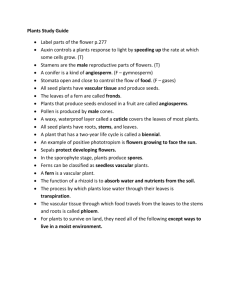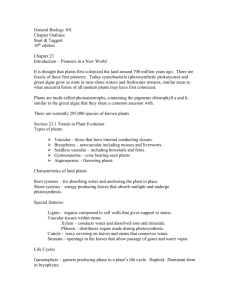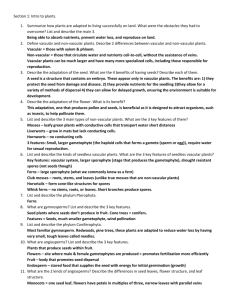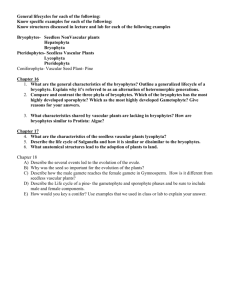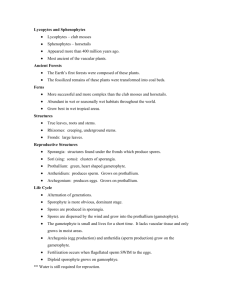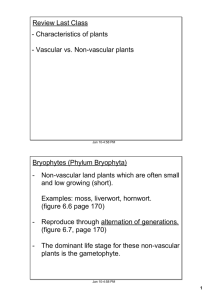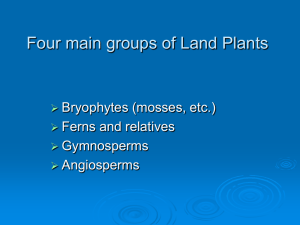Student Handout
advertisement
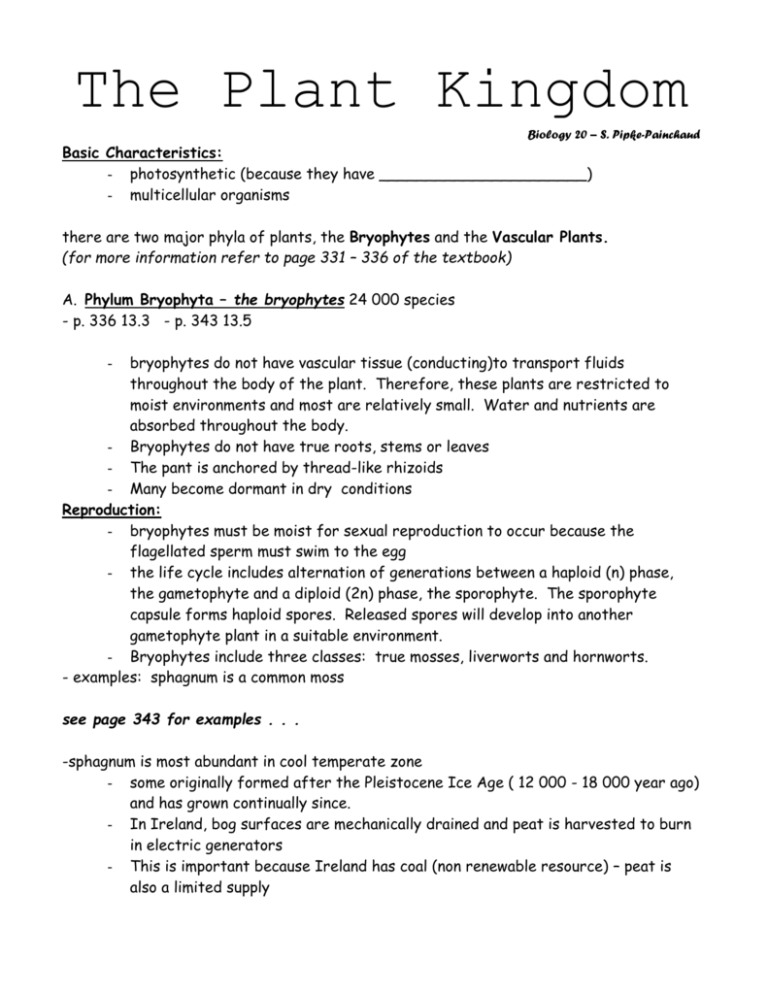
The Plant Kingdom Biology 20 – S. Pipke-Painchaud Basic Characteristics: - photosynthetic (because they have ______________________) - multicellular organisms there are two major phyla of plants, the Bryophytes and the Vascular Plants. (for more information refer to page 331 – 336 of the textbook) A. Phylum Bryophyta – the bryophytes 24 000 species - p. 336 13.3 - p. 343 13.5 bryophytes do not have vascular tissue (conducting)to transport fluids throughout the body of the plant. Therefore, these plants are restricted to moist environments and most are relatively small. Water and nutrients are absorbed throughout the body. - Bryophytes do not have true roots, stems or leaves - The pant is anchored by thread-like rhizoids - Many become dormant in dry conditions Reproduction: - bryophytes must be moist for sexual reproduction to occur because the flagellated sperm must swim to the egg - the life cycle includes alternation of generations between a haploid (n) phase, the gametophyte and a diploid (2n) phase, the sporophyte. The sporophyte capsule forms haploid spores. Released spores will develop into another gametophyte plant in a suitable environment. - Bryophytes include three classes: true mosses, liverworts and hornworts. - examples: sphagnum is a common moss - see page 343 for examples . . . -sphagnum is most abundant in cool temperate zone - some originally formed after the Pleistocene Ice Age ( 12 000 - 18 000 year ago) and has grown continually since. - In Ireland, bog surfaces are mechanically drained and peat is harvested to burn in electric generators - This is important because Ireland has coal (non renewable resource) – peat is also a limited supply - - Peat contains sphagnum associated plants it contains pollen grains from surrounding plants which provides a log of the vegetative changes over the years. Animals and humans in bogs are well preserved “bog Man” Vascular Plants: A REVIEW. . .or An Introduction Phylum Tracheophyta – 211 000 species - adaptations of most vascular plants to conserve water have allowed them to inhabit most locations in the biosphere Characteristics: - have conducting tissue (vascular) to transport water and dissolved nutrients - true leaves and stems and well – developed root systems - they are adapted to conserve water (waxy cuticle) - vascular plants may reproduce by spores or seeds and do not require water for sexual reproduction - they also exhibit a life cycle with alternation of generations Two basic groups of vascular plants are seed–producing and spore-producing. Seed Producing Vascular Plants: 1. Angiosperms (Flowering Plants) 200 000 species - the flower is the reproductive structure of an angiosperm - the sperm is transferred in pollen grains to the egg within the carpel of a flower. This zygote develops into the seed, protected within a fruit. Part of the seed embryo consists of one or two modified leaves called cotyledons, a and a root. The seed also contains a food supply, either in the form of endosperm or stored in the embryo itself. Two classes of flowering plants: Monocotyledons: - single cotyledon in the seed embryo - parallel veins in long, narrow leaves - flower parts in multiples of three - includes grasses, sedges, cereal crops (wheat), rice and corn - important source of food for humans Dicotyledons: - two cotyledons in the seed embryo - branched venation in the leaves - flower parts in multiples of four or five - includes most fruits, vegetables, trees and shrubs 2. Gymnosperms: (Conifers) 700 species - most conifers are evergreen - most are woody trees or shrubs with needles or scales for leaves. This form of leaf is well adapted for dry environments due to its low surface to volume ratio and thick waxy cuticle. - Conifers produce seeds attached to the upper surface of scales grouped in cones (naked seeds) - Includes the juniper, larch, pine, spruce, fur - Provide pulp and paper/ lumber Draw the following Diagrams: Cone Cross Section: Scale with Seeds Pollen Grain Did You Know???? 1. Bristlecone Pine (found in Calif. And Nevada) - 4900 years old - not good wood so it is safe from logging - but tourists are breaking off pieces to keep 2. Redwoods of California (some of the tallest trees in the world) - 372 ft high - largest tree is 273 ft tall and 84 ft wide – 4000 years old 3. Ginkgos (different shaped leaves) - nearly extinct but were saved by monks in a monastery - humans actually preserved instead of destroyed - wide spread and popular because of disease resistance high pollution tolerance Spore Producing Vascular Plants: 1. Club Mosses: (p. 344 13.6) Division Lycophyta - are low growing evergreen plants - though they look like mosses they are not true mosses, they contain vascular tissue - club mosses reproduce by means of spores formed on upright branches with club shaped cones. 2. Horsetails (p. 345) Division Sphenophyta - these plants have hollow jointed upright branches growing from horizontal underground stems - small scale-like leaves grow at each joint - horsetails grow in moist locations - their tissues contain silica, a compound present in sand, and are harsh to the touch - spores are produced in cones at branch tips - horsetails are often called scouring rushes because they were used by prairie travelers to clean pots and pans. 3. Ferns: (Filicopsida) p. 346 13.7 - the fern is a shade dwelling plant with underground stems and roots. The upright portions of the plant are leaves. - The fern life cycle consists of a tiny gametophyte stage and a large sporophyte stage. - no seeds have spores - Spores develop on the underside of fern leaflets on clusters of sporangia (appearing as brown spots (sorus)). Spores are dispersed when ripe. (special mechanism releases the spores) - need water to reproduce (need a moist environment) - a small heart shaped prothallus develops - when it rains or there is morning dew the sperm swim from the antheridium (male) to the archegonium (female)– where fertilization occurs - a young sporophyte develops and grows into the ferns that we recognize today. - Most fern species are found in the tropics but many occur in forest ecosystems. Psaronius (extinct fern lived millions of years ago) was several meters tall and had fronds with leaves and branches up to 2 meters long) Was not made up of wood (no secondary growth) But had a diameter of up to 30cm Was supported by a mantle of extra roots and leaves - refer to fern lifecycle diagram Fern Resource: New Zealand Plants – University of Aukland http://www.sbs.auckland.ac.nz/info/schools/nzplants/fern_intro.htm#overview1 Complete the following questions: p. 343 #1-7 p. 347 # 1-4 p. 358 #1-3
